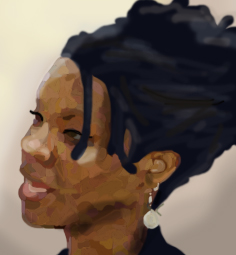
Kimberly Dixon-Mays is a poet, playwright, and performer. A Cave Canem and Ragdale fellow, she has published in journals including The Drunken Boat, Torch, Versal, and Reverie, and she released her first poetry collection, SenseMemory, with Blue Pantry Publishers. From 2004 to 2010 she was a writer and performer with the Poetry Performance Incubator project of the Guild Literary Complex. She became executive director of the Complex in 2010, producing the Incubator, the Gwendolyn Brooks Open Mic Awards, and several other literary events and programs around Chicago. I interviewed Kimberly earlier this month to discuss “Hyde Park Walking Tour” and her own history with the neighborhood.
“Hyde Park Walking Tour” comes out of the Guild Literary Complex’s Poetry Performance Incubator. What’s the story behind that?
The Poetry Performance Incubator is a program that was started in 2004 by the Guild’s executive director, Ellen Wadey. It brings together poets—who are normally very solitary and autonomous—to create original theater and think about things like audience, performance, and delivery. At the time I was a contestant for one of the Guild Complex’s other programs—the Gwendolyn Brooks Open Mic Awards—and Ellen recruited me to direct the Incubator program. I ended up joining as a participant instead and stayed in the program all the way through 2010, when the Incubatees developed their first full play, Tour Guides, with artistic director Coya Paz. My own background is in theater. As a child, poetry was read aloud to me, so I’ve always thought of poetry in a performative way.
What’s your own history with Hyde Park? Clearly you have a deep familiarity. I’m interested in the way “Hyde Park Walking Tour” goes beyond the easy ways of talking about the neighborhood—town vs. gown, the big bad University, etc.
I moved to Hyde Park around 2004, from having lived in Evanston since 1996. I was excited to move there, because it has the pace of a university town without being right in the hustle and bustle. There’s ethnic and age diversity. There are a lot of single people who aren’t starting families. I was never formally affiliated with the University, but my older brother was a graduate. My first taste of Chicago was through him, when I would visit him from back east while I was still in high school.
I definitely felt the hand of the University. I recognized how my life was shaped. Everything from who my neighbors were and how the bus routes were to what it was like to ride the bus at certain times of day and changes to development in the neighborhood. Like many, I’ve felt torn about the University in terms of what it’s brought—it’s done wonderful things and other things that could have been done differently, better. It’s this ambivalence that the piece is trying to tease out.
As a Hyde Parker, there’s this acute awareness of, and discomfort with, the neighborhood’s fraught history. Your last paragraph brings that guilt, in many different forms, into sharp relief.
I was very purposeful with talking about different types of guilt—I start with white liberal guilt, but move on to other types: “black professional guilt, young Turk guilt, battle-weary guilt.” The piece came from a prompt in an Incubator rehearsal about gentrification, and is informed by my own experiences moving into and residing in the neighborhood. It was important to me to implicate a number of different kinds of people, because that’s what Hyde Park is.
There’s quite a bit of humor here, too. You speak sarcastically of how beyond the borders of Hyde Park, “there be dragons.” How do you see this humor playing a role in the piece?
The humor helps to earn the right to say something that may be controversial. It also gets at the absurdity of what’s being said, or implied, when we talk about Hyde Park—“there be dragons” indeed. There is racism and classism implicit in a comment like that. I tried to make the humor be about the speaker’s own discomfort with what they were saying and feeling internally, which comes in part because it’s being performed by an African American (me). The humor comes from this discomfort leaking out and undercutting the speaker’s other fawning words about Hyde Park, “our oasis in an oasis.”
Hyde Park, like all neighborhoods, is in flux. With all of the new development on 53rd Street, and the University’s push south, there’s a keen sense among residents that the neighborhood is changing. Any thoughts on the shape this development is taking?
I’ve moved out of the neighborhood, so it’s a little hard for me to say—the things that might seem great from the outside might not be great if you’re living there 24/7, and vice versa. It’s definitely changing significantly. I’m reluctant to affiliate myself with folks who say it’s changing too much, but I also recognize there’s something to be said for its quirkiness, character, and distinctiveness that is worth preserving.
My older brother, the UChicago alum, would talk about how some of his classmates would visit Northwestern and it felt so odd to be on a campus like that. Somebody described it as country club-ish. They were proud of the rough edges of the UofC. I wonder if people who are expressing ambivalence, including myself, are mourning the passing of some of those rough edges, the particular character of the neighborhood. Even the phrase “rough edges” is problematic, though—I mean it as more of a metaphor about the neighborhood’s character than a geographic statement about what surrounds Hyde Park. “Hyde Park Walking Tour” challenges the myth that horrible things live just past the border of the neighborhood, and the contrast that has been cultivated where Hyde Park is this jewel of the South Side keeping what’s outside at bay.
Rachel Hyman is the founder and head editor of Anthology of Chicago, a neighborhood-focused literary project where “Hyde Park Walking Tour” was first published.
